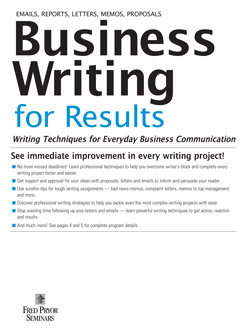Business Writing for Clarity and Impact

The best writing is clear communication that your audience can understand and use. This helps increase effectiveness and accountability – in other words, your writing will have greater impact, because people will know what to expect next or what to do. Clear writing also demonstrates openness and transparency –overly technical language can lead the reader to feel like you are hiding something, or purposefully being evasive. Not good in getting your message across! In this article, we review tips for writing documents that are clear and have high impact.
The Challenges and Benefits of Clear, Plain Language
Some people become a bit intimidated when they need to write. The result can be overly formal words and sentence structures, as the author tries to communicate the importance of the topic or overly technical jargon, because the author is more comfortable with the subject matter.
SAVE $10 AND TRAIN ON THIS TOPIC TODAY
So why is this so hard? There are some real factors that make clear and plain language difficult.
- You are using unclear or highly technical content as a base. If your source material is highly detailed and complex, it can be hard and time consuming to make it clearer. This can lead to the default of using unclear content. Good writing is often a translation activity – recognizing that can help you get started.
- The context is nuanced, and you don’t want to over-simplify it. You are trying to communicate clearly, but the first phrases that come to mind are: “Well, it’s complicated…” or “Well, it depends.” And, sometimes it’s complicated, and sometimes it does depend. The key is to name and break down those complications and dependencies in a way that is clear and helps others use that information.
- You may be trying to write for everyone. If you try to focus on one audience, you may leave someone out. The result? Generic material that isn’t really applicable to anybody. Unfortunately, when we have to cover everyone, we don’t cover anyone well. Start with a single audience, and then supplement with others once you have the core developed.
- There may be a lack of clarity in the topic you are writing about. For example, it’s hard to be clear on roles and processes using clear plain language when those rules and processes have not yet been defined. It is hard to be clear with an audience what you want them to do, or how to do something, when you are not clear yourself. Ambiguity tends to lead to convoluted writing – manifested often in the passive voice. (Example: “Your request will be reviewed by the appropriate personnel.”)
Moving to plain language means actively talk about audiences and their needs and goals. It means clarifying processes and expectations, so you can write more clearly about them. This may take some conversations before putting pen to paper. Good writing can drive organizational change. Be brave and ask the questions.
Understanding Audiences and Actions
Let’s look at the actions that these audiences generally take. This is very important in analyzing your material for clear and plain language.
- Customers include the targeted groups of people who use your services or products. Generally, they need information that will compel them or help them access and use your resources, and the steps needed to access those resources.
- Partners and advocates (or brand ambassadors or influencers) support your mission and spread your word. Partners and advocates often magnify your voice with the audiences that you want to reach.
- Internal leaders set priorities, make decisions and solve problems. They generally want to understand costs and benefits, fit with mission, successes and risks.
- Candidate customers and advocate. These are the people that are not quite sure they want to do business with you, and want or need to learn more.
Clear and plain writing often begins with picturing one of these groups, and writing directly for them.
Outlines and Organization
Once we know our audiences and our goal, we can structure and organize our communications to meet those needs. Here are some common types of documents, with a summary standard outline for each. Following these outlines for each type can save you lots of time and can result in a clearer product.
- Presenting process steps. State the audience and the goal. Who is doing the process and what is their goal? Then, walk through the steps involved in the process. For each step, who is doing what, when are they doing it, where are they doing it and why and how are they doing it? Once you have walked through the steps, state the endpoint or product that should result. The steps need to include what you and the audience will or should do.
- Asking for a decision. First, make the ask clear, so the reader understands what decision is required. Second, outline what the current state is, what the problem is and what the desired change and outcome is. Next, lay out the solution you are recommending: what it involves, why it is the right path and possible risks. Then, lay out alternatives you considered, but discarded. Then, state the advantages of the proposed alternative, and why it’s better than the discarded alternatives. Finally, remind the reader what the decision is that is being asked for, and what the next steps will be. If you don’t know what the proposed decision should be, present options with the pros and cons.
- Communicating a decision. Be clear on what the decision is and who is impacted. Then, talk about the benefits. Why did we take this action? What problem does it solve? What are the anticipated benefits? Then, counter possible objections to the decision. What might people raise as concerns or risks? How are we addressing those? Then, walk through what is next. What will change and what happens next? The closing is a reminder of what the decision is, a quick summary of the benefits and the immediate next steps and timeline.
- Presenting controversial issues. Name and acknowledge the controversy or issue. Then, state the impact, including who is affected. This shows your audiences that you understand what is going on and that you have empathy for those involved. Next, outline the different perspectives or the variables involved. The purpose here is to frame the issue in a logical way. Close by acknowledging the impact of the issue on the parties involved. Even if you are not ready to do anything, just sharing that you are aware of the situation, and that you care, may help.
- Generic outline. If you are not sure what category your document falls into, start with this generic approach. Starting by summarizing what the topic or problem is, and why it matters. Next, or in connection with talking about why, talk about who. Who cares about this topic? If you can’t clearly identify who cares about this topic, you may not need to be writing about it at all. Next, write about any critical elements that are involved in the topic. These will vary depending on what you are talking about. End with what’s next, if anything.
Looking Beyond the Words
Now that we have talked about the words and possible outlines for your writing, let’s look at tips for presenting your content in an appealing way:
- Headings and Bullets. In today’s information packed world, we write for skimmers, rather than readers. This means using headings, sub-headings and bullets to organize and present small chunks of information.
- Short Paragraphs. After writing some text, count the lines in each paragraph. If your paragraph is longer than 8 lines, consider how to shorten or split it.
- Bullets. Bullets encourage parallel structure when presenting steps or lists, and can be used to replace long strings of text.
- Clear, Active Voice. Try skimming this: “An article was written by an author with the goal of teaching you how to write with maximal effectiveness.” Not so easy to skim! What made it difficult? Too many clauses, passive voice and too long. How about: “This article teaches you how write effectively.” Same content, much easier to read. Take Home: Edit for clarity and readability.
- Tables and Figures. Graphics list or present multiple variables across different entities, showing relationships and streamlining data. A picture truly can be worth a 1,000 words.
- Use White Space. The space on your paper with nothing on it – between paragraphs, around graphics, at the end of short bullets – gives your reader space (both physically and mentally) to process.
- Call-Outs. Short boxes with key phrases or short text are very helpful in pointing to key points. They can be used to summarize next steps or actions, highlight critical reference points, or provide supportive quotes. Callouts are generally very short, and include the information that you most want your audience to remember.
Making your document visually appealing increases its clarity, accessibility and readability!
Summary and Next Steps
To close, here is a summary of the advantages of using clear and plain language:
- It forces you to ask and answer practical questions. When you try to explain who’s going to do (or did) what, when, why and how, you must focus on practical questions that may not have been answered.
- It generally lead to fewer follow-up questions because people understand what you’re saying. This saves time for you and your audiences.
- It allows others to speak for you accurately. You want people to advocate for your ideas and views, and communicate your successes. Helping these people understand what you do in a clear way helps them speak on your behalf more accurately.
- It reduces review time, because people who can share your writing with others will be able to read and understand your work faster.
Here are some specific learning series that Pryor offers to help you develop clear plain writing skills. You can find these by searching Pryor’s catalogue in the category of Business Writing and Grammar:
- The Writing in Plain Language Series includes nine lessons focusing on different elements of clear writing.
- The Writing Basics Series and Writing Clearly Series include writing and grammar basics in a range of critical areas, sin quick digestible sections.
- The Business Writing Series focuses specifically on document types you might encounter in your job, and common areas where writers may face challenges.
- More specialized writing courses include the on-demand webinar Writing for the Web and the online course Plain Language for Government, and the on-demand webinar Bad Email Habits.
- The Business Writing and Editing for Professionals on-demand webinar is also a great way to review best practices for keeping your business communications and correspondence professional, on point and error-free.






